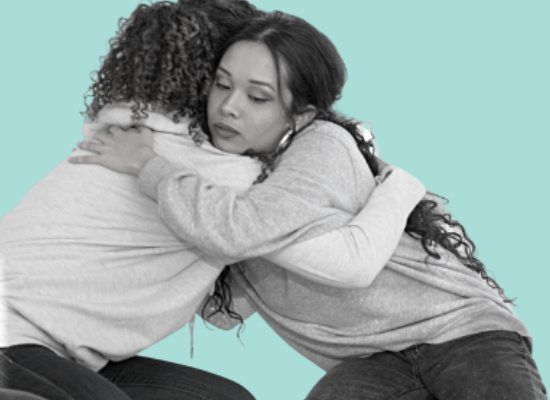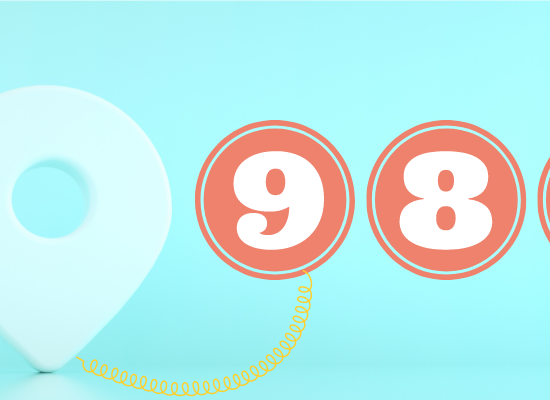
Michele LeCloux believes 988 has the potential to decrease the stigma associated with mental health. “I’m excited for 988 and to see how it changes the general perception of mental health,” she says. LeCloux is the crisis services coordinator at the Milwaukee County Department of Health and Human Services Behavioral Health Division (BHD) Crisis Services. The three-digit number could help normalize mental health concerns and, consequently, “make it more commonplace for people to call a mental health professional directly and receive services.” However, LeCloux points out it’s essential that communities have a continuum of care to turn to and that accessing any part of it is user-friendly. That’s why the county has worked to ensure its crisis intervention services are robust and include a call center, mobile crisis, crisis stabilization, and follow-up services, making the community well-positioned for when 988 goes live on July 16, 2022.
According to Lauren Hubbard, RN, BSN, director of Community Crisis Services at BHD, the division’s goal for their crisis care system has been to create a “No Wrong Door” approach by promoting early crisis intervention and prevention, enhancing access to care, and providing crisis support services that are person-centered and integrated into the community while supporting the division’s mission—“Right Care, Right Place, Right Time.” (Called the three Rs.) Hubbard says the division wants residents in crisis to get the right response every time.
Hubbard explains that the Milwaukee County Mental Health Board has heavily invested in supporting a comprehensive continuum of community-based crisis services as a result of guidance in Emergency Mental Health Services Programs, commonly referred to as “DHS 34” from the Wisconsin State Legislature Department of Health Services (DHS). The state code requires all counties to operate emergency mental health services for persons in need of crisis services, including a 24-hour crisis telephone line and face-to-face contact for DHS-certified crisis services. LeCloux explains that crisis services are mainly financed by county tax levies. In addition, some mobile crisis services are Medicaid-reimbursable, such as mental health assessments, crisis stabilization and management, linkages to community resources and referrals, case management, and service coordination with crisis stabilization services.
Crisis Line
The behavioral health division operates a countywide, 24/7 mental health and suicide Crisis Line (414-257-2222) that serves as the entry point for accessing crisis services. The line is staffed by trained master’s-prepared mental health clinicians and registered nurses; some staff receive clinical supervision hours to obtain their clinical or professional licensure as a part of BHD’s professional training program. These trained staff screen each call and assess the needs of each caller in mental health or suicidal crisis.
LeCloux explains that the Crisis Line operates in collaboration with the county’s 211 center, IMPACT 211, which initially answers and triages Crisis Line calls. LeCloux notes that this partnership started about three years ago because most calls to the Crisis Line were about “quality of life” concerns, meeting basic needs such as food insecurities, housing, and paying bills. “These are all completely valid crisis calls but not the Crisis Service staff’s expertise.” It made more sense for IMPACT 211, with its extensive and up-to-date community resource database, to first take county crisis line calls and then forward mental health crisis calls to the behavioral health division’s mobile crisis services team. In fact, IMPACT 211 staff conduct an initial behavioral health screening and assessment. If the caller is experiencing a suicidal crisis, they transfer the call to the mobile crisis services call line, which also answers National Suicide Prevention Lifeline calls.
Mobile Crisis Services
Mobile crisis teams carry out the core assignments of community-based crisis services. They’re staffed by mental health professionals, including clinical social workers and psychiatric nurses. LeCloux explains the teams have daily assignments, rotating between the office/call center, the psychiatric emergency room and observation unit at BHD, or providing in-person services within the community and crisis stabilization houses. She highlights that the staffing assignments rotate daily between the teams, providing variety in their work responsibilities while also reducing workforce burnout.
The mobile crisis teams assigned to the office are responsible for answering both Lifeline calls and the crisis calls transferred from IMPACT 211 to the mobile crisis services’ direct line where staff conduct suicide risk assessments, de-escalate mental health or suicidal crises, and assist callers in developing safety plans—step-by-step guides where callers can identify coping strategies and sources of support.
For most callers, their crises can be de-escalated with these telephonic interventions. However, when a caller is having imminent thoughts of hurting themselves or others, the office team will collaborate with the caller to engage the mobile crisis team assigned to community response. That mobile crisis response team will meet the caller wherever they are in the community, conduct a mental health assessment, and provide resources and support. LeCloux explains that this assistance includes “helping a person go to a voluntary inpatient unit by driving them there, helping them with the intake process, and making sure they are feeling safe at that point.”
LeCloux shares that sometimes a caller’s immediate medical need is a priority. In this scenario, the office mobile crisis staff work closely with the caller to engage emergency medical services (EMS) through a three-way call. The office mobile crisis staff will stay on the line with the caller throughout the EMS response. To further support the caller, the community crisis mobile team is also dispatched to provide emergency mental health crisis services in hopes of reducing the caller’s crisis at that moment. EMS technicians triage the medical needs of the individual while the community mobile crisis team addresses the individual’s mental health needs.
The county’s behavioral health division is one of five Lifeline-affiliated crisis call centers in Wisconsin and has been part of the Lifeline network since it was launched by the U.S. Substance Abuse and Mental Health Services Administration (SAMHSA) on January 1, 2005. LeCloux adds, “Lifeline is naturally part of the work that we do…it’s a part of what we provide for our community.” The division decided that calls to the Lifeline (1-800-273-TALK) generated from the Milwaukee County area code 414 would be directly routed to the BHD’s mobile crisis team’s direct office line rather than their county crisis line because people calling the Lifeline have already self-identified that they or a loved one is experiencing a suicidal crisis.
In 2020, the Crisis Line triaged and handled 23,436 calls. Of those, 5,436 were transferred to the mobile crisis services’ direct line for additional clinical assessment and support. In addition, the mobile crisis team answered 3,684 Lifeline calls. The mobile crisis team also provided 2,888 community responses. LeCloux and Hubbard underscore that the service utilization data reflect that community residents are reaching out and accessing crisis care services, stressing the importance of striving for the department’s “No Wrong Door” approach. “Over time, we want to be more proactive instead of reactive as a larger system,” says Hubbard. “The more we respond, the more we help people in the moment and get them connected to community-based services. Hopefully, the word gets out that it’s a service that they found valuable and meaningful, and they will refer us to the next person.”
During the past few years, LeCloux says the mobile crisis teams have been strong at following up with community residents who were connected to mobile crisis services. Follow-up services are provided to Lifeline and Crisis Line callers on a voluntary basis either by phone or in person. She explains, “A part of the follow-up is talking about the resources—how did that resource work out, was it a good connection, how can we re-do things a bit?” Information gathered during the follow-up provides feedback on how to improve the service delivery system.
Hubbard elaborates, “The mobile crisis teams do a very good job of community linkage and executing follow-up strategies for reaching transient communities. They may or may not have access to a phone the next time and that’s part of that good conversation we have on where to meet, when to meet, and on what day…That’s an opportunity for us to engage on that person’s terms of where they are.”
Crisis Stabilization Services
The third key assignment for mobile crisis teams is performed at the county’s psychiatric crisis service emergency room and observation unit, located within the behavioral health division’s mental health complex. This county-operated service provides crisis intervention and in-person psychiatric assessment, treatment, and referral 24/7. The individual in crisis is evaluated to determine if inpatient admission is the best course of action for their recovery process, or if other treatment options are more appropriate. As an alternative to inpatient hospitalization, the observation unit provides crisis services and stabilization for community residents needing brief crisis intervention for up to 48 hours. The mobile crisis teams assist with treatment, short-term case management, and discharge planning. “The beauty of this approach is that it could be a person we saw in the community who could be coming into the observation unit or returning back to the community. It could be helpful on either end of that with some follow-up planning,” comments LeCloux.
As part of the county’s continuum of crisis services, patients discharged from inpatient hospitalization may be referred to one of the county’s two, 16-bed crisis stabilization houses. The houses provide short-term stays of two weeks or long-term stays of four to six months. LeCloux shares that the mobile crisis teams provide clinical services, such as assisting with medication management, case management, community linkages, and discharge planning. The mobile crisis teams collaborate with a community peer support program, referred to as the Community Linkages and Stabilization Program (CLASP), who work with residents to promote healthy activities that support their recovery process.
The division’s crisis care model illustrates how mobile crisis teams are the central hub for the county’s crisis care system, aligning with the core crisis elements outlined in the SAMHSA publication, National Guidelines for Behavioral Health Crisis Care—A Best Practice Toolkit. The National Guidelines for Crisis Care hold that the essential elements of an integrated crisis delivery system should be a 24/7 crisis call center, crisis mobile teams, and crisis receiving and stabilization centers.
Statewide Crisis Call Center
Last year, DHS awarded a multi-year, multi-million-dollar contract to Family Services Crisis Center in Green Bay to support a 24/7 statewide crisis call center, known as Wisconsin Lifeline. On August 1, 2020, Family Services Crisis Center started providing backup Lifeline coverage to counties not covered by one of the four Wisconsin-based Lifeline providers. This statewide backup center for Lifeline calls increases the likelihood of Wisconsin callers receiving a local response before being routed to Lifeline’s national backup network. “Especially during the pandemic, we wanted to make sure we were providing sufficient emotional support by increasing our capacity to answer Lifeline calls,” shares Jenny Younk, Lifeline Program Manager with Family Service Crisis Center.
With this $2 million annual investment from Wisconsin’s annual share of SAMHSA’s Community Mental Health Services Block Grant, the center created a separate program to specifically answer Lifeline calls. They hired 15 full-time phone counselor staff members; a program supervisor who oversees the program operationally; a program coordinator who supports the supervisor; a clinical supervisor; an outreach coordinator; and other part-time positions, in total 18 full-time staff members and additional administrative staff.
The outreach coordinator is an integral element of the center’s Lifeline team in engaging counties and call centers across the state. The coordinator works to connect with all counties to make them aware of the Lifeline program and the services they provide. “A guide is being created for what services are available for each county so crisis call centers can support callers from those counties. Then counselors can quickly connect callers with local resources and facilitate warm handoffs and/or mobile crisis if necessary,” Younk explains.
The outreach coordinator attends area administration and advisory committee meetings across counties, engages with stakeholders for 988 planning, and conducts outreach to law enforcement and hospitals about Lifeline and crisis services. These meetings foster collaboration and education across the Wisconsin crisis service landscape by allowing different elements of the continuum to be aware of one another and better connect individuals to the most appropriate services available.
To ensure that all Wisconsins are aware and able to access crisis resources, the center is increasing marketing efforts to reach vulnerable populations in a relevant and accessible way. Younk shares, “We are analyzing call data to identify populations at greatest risk of suicide.” For example, Wisconsin Lifeline is looking at the farming population and exploring suicide prevention marketing efforts via sporting and agriculture magazines to increase outreach efforts. As a result of DHS’s investment, the in-state answer rate for Lifeline calls across Wisconsin has grown dramatically from 30% to 91%, and their work should prove particularly beneficial based on projected call volume increase when 988 is launched in the summer of 2022.
The call volume has grown monthly, and the center has been able to meet the demand. “As call volume has escalated,” says Younk,” staff has done an amazing job of continuously answering calls while we ramp up our center.”








